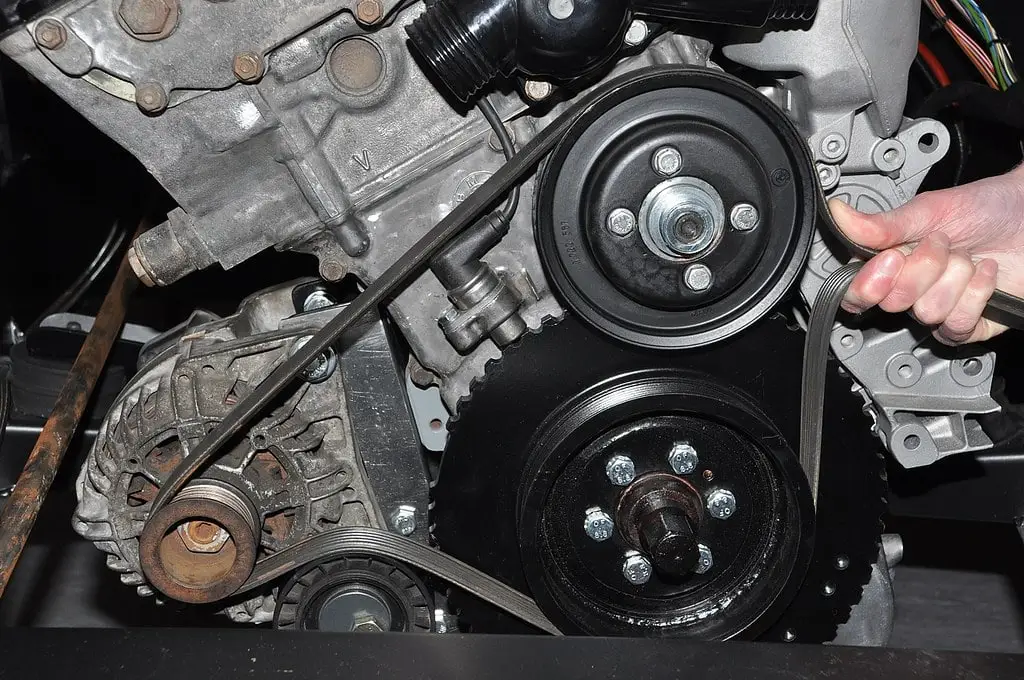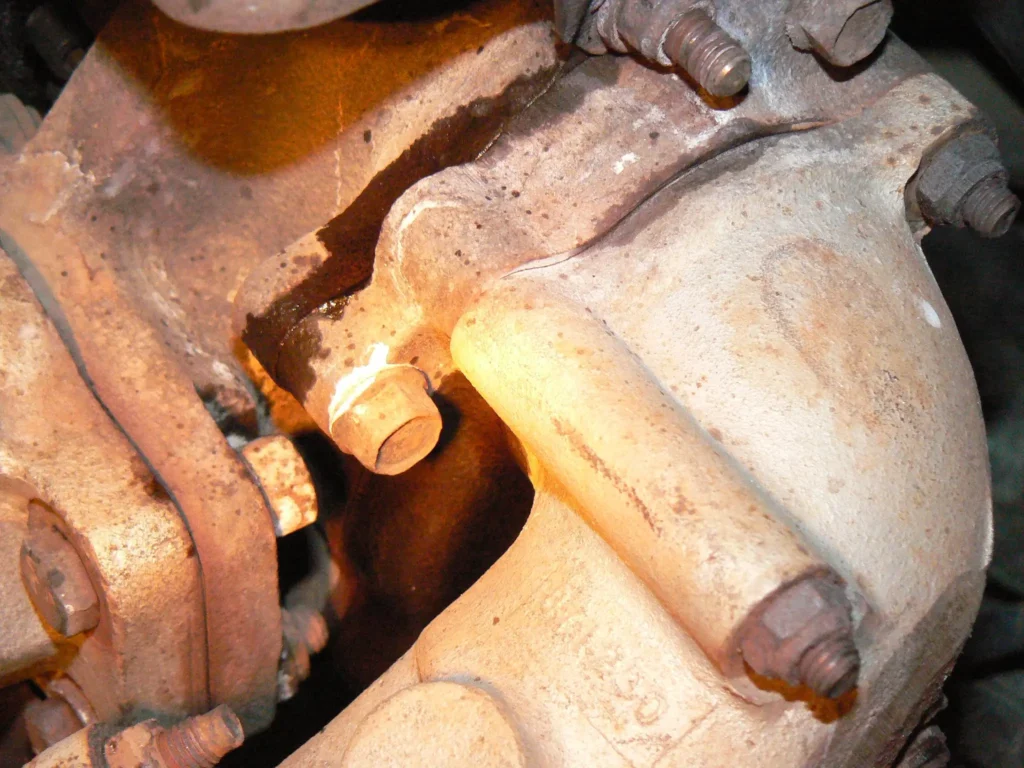A car’s engine tensioner is a small but important component, whether for the timing belt or accessory drive belt. When working correctly, it ensures constant tension on the belts to prevent slippage. But when worn out or faulty, Can a Bad Tensioner Cause Loss of Power? and other drivability issues.
we’ll compare OEM, aftermarket, and lifetime tensioners to help you choose the right replacement when needed.
So if you want to understand everything about bad engine tensioners and their impact on engine power, keep reading!
What is a Tensioner Pulley?
Before jumping into tensioner problems, let’s recap what a tensioner is and how it works normally in a vehicle:
A tensioner is a spring-loaded or hydraulic pulley that applies continuous tension to keep the timing belt or serpentine belt tight as it rotates through the engine accessory systems. This tension prevents slippage as the belts age and stretch over miles of driving.
The two main types are:
Timing belt tensioner – Keeps proper tension on camshaft timing belt or chain to synchronize valve/piston timing. Critical for engine performance.
Accessory or serpentine belt tensioner – Tensions drive belt running accessories like the alternator, power steering pump, and AC compressor. Less critical but still important.

On both types, the tensioner pulley has an inward spring or hydraulic pressure pushing out against the belt backbone. This automatically adjusts for stretching over tens of thousands of miles.
Now let’s look at what happens when this important pulley goes bad!
Signs of a Worn Tensioner Pulley
A failing tensioner will show some or all of these symptoms long before it fails:
Squealing noise – As internal bearings wear, the pulley starts to wobble and the belt slips on accessories, causing a high-pitched squeal
Visible pulley wobble – Bad bearings cause excessive side-to-side movement
Belt fraying – Loose belt whips against pulleys, wearing and tearing the edges
Tensioner leakage – Hydraulic tensioners start to leak fluid due to seal wear
Increased vibration – Loose belts increase harmonic vibrations through the accessory drive
Difficulty rotating – Bearings seize up causing the pulley to stop spinning freely
Excess movement – Weakened spring allows excessive tensioner arm movement
Can a Bad Tensioner Cause Loss of Power? Any of these symptoms mean the tensioner needs attention. The longer it’s left, the more likely the belt will fail.
Now let’s look at how a faulty tensioner impacts engine operation…
Consequences of Driving with a Bad Tensioner
Allowing a compromised tensioner pulley to remain in operation risks a range of problems:
Premature belt failure – Loose belts eventually shred, snap, or dislodge, stopping accessories
Accessory component failure – With worn belts slipping, components like the water pump and alternator overheat and fail fast
Engine overheating – A dislodged belt also stops the water pump, leading to rapid overheating and head gasket failure
Loss of accessories – No belt means loss of power steering, AC, electrical charging, and more during a breakdown
Timing belt disintegrating – A loose camshaft timing belt destroys the valve timing, usually bending valves and damaging pistons
Complete breakdown – Accessory belt failure strands you roadside. Timing belt failure usually totals the engine.
But one consequence many owners ask is…
Can a Bad Tensioner Cause a Loss of Power?
Yes – an excessively worn tensioner can directly sap engine power in two ways:
1. Added drag and friction – Seized bearings stop the pulley from spinning freely. This adds physical resistance for the crankshaft to drive accessories, robbing power.
2. Timing belt slippage – Loose camshaft timing belts throw off combustion timing. Misfiring and inefficient burning wastes gasoline energy, reducing useful power sent to the wheels.
The bottom line? A bad tensioner allows belt slip leading to lower MPGs. And seized bearings drag down performance. Even a couple of HPs robbed by a faulty tensioner are noticeable behind the wheel.
Now let’s look at related problems with rough idle, acceleration, and charging…
Related Problems: Idle, Acceleration, Alternator Issues
Can a Bad Tensioner Cause Loss of Power? Besides direct power loss, bad tensioners also contribute to:
Rough idle – Timing belt/chain instability at idle allows misfiring. Accessory belt slip can stall the idle air control valve.
Poor acceleration – Any loss of engine power means slower throttle response. Significant timing belt instability gives weak acceleration.
Alternator problems – Accessory belt slippage reduces alternator RPMs. This causes dimming headlights, flickering gauges, and dying batteries.
So a failing tensioner should be considered as a potential cause if you experience rough idling, bogging acceleration, or electrical issues.
Next, let’s cover diagnosing problematic tensioners…
Diagnosing and Testing a Bad Tensioner
Can a Bad Tensioner Cause Loss of Power? Some symptoms point directly at a worn tensioner, like visible pulley wobble. But others could come from worn belts or accessories themselves. So how can you test and confirm it’s the tensioner at fault?
Manual tensioner movement – Set to max AC or power steering load to remove belt slack. Then try gently moving the tensioner arm with a socket wrench. Too easy = weak spring.
Pulley spin test – Remove belts then spin the tensioner pulley. Seized bearings stop spinning quickly compared to a healthy spin.
Belt tension gauge – Use this special tool to measure static and dynamic belt tension. Compared to factory spec – too low/high indicates spring failure.
Fluid leakage – Check below the hydraulic tensioner for signs of leaked fluid. Seal damage causes loss of internal pressure.
Replacing belts or accessories without fixing tensioner problems usually leads to premature failure of the new parts.
Next, let’s look at when to change failed tensioners…
When Should You Replace a Bad Tensioner?
Can a Bad Tensioner Cause Loss of Power? With tensioners being relatively inexpensive engine parts, trying to squeeze out their last miles before replacement usually just leads to damage elsewhere when they eventually fail.
The general recommendation is:
Replace at first signs of wear – Squealing, wobbling, or fraying belts mean tensioners are past the point of adjustment and will only degrade further.
There are a few exceptions where you can continue driving carefully:
- Tensioner bearing seized but belt/engine unaffected
- Noisy tensioner but belts staying tight
Otherwise, replace faulty tensioners right away along with worn belts and damaged accessories. This avoids getting stranded out on the roads.
Now for some final frequently asked questions…
FAQs on Can a Bad Tensioner Cause Loss of Power?
What problems can a bad tensioner cause?
Excessive belt wear and tear, premature failure of water pumps/alternators, engine overheating, loss of electrical and steering components, reduced fuel economy and acceleration, rough idle, and further engine damage.
Can a faulty tensioner cause a loss of power?
Yes, worn bearings add mechanical drag, robbing up to several horsepower. And timing belt instability reduces combustion efficiency.
Can a bad tensioner cause slow acceleration?
Timing belt slip causes weak throttle response and lackluster acceleration. Accessory belt issues can affect sensors.
Can a bad tensioner cause engine vibration?
Loose accessory belts increase torsional vibration through the pulleys and shafts. So increased vibration at idle hints at tensioner wear.
How do you diagnose a bad tensioner?
Check for noise, play, and spinning. Use a tension gauge and compare it to factory spec. Leaking fluid indicates hydraulic failure.
How do I know if I need a new tensioner?
At the first signs of noisy, loose, or shredded belts, binding tensioners’ observable damage indicates they are excessively worn internally and are due for replacement.
OEM, Aftermarket, or Lifetime Tensioners – Which is Best?
When you do need new tensioners, you have a choice between:
OEM tensioners – Original equipment from the car manufacturer – more expensive but restores engine to factory condition.
Aftermarket tensioners – Third-party replacements offering OE fit and function for lower cost – range from basic to premium.
“Lifetime” tensioners – Hydraulic tensioners designed for the engine’s life without adjustment. Cost extra initially but doesn’t require regular replacements. Popular performance upgrade.
Can a Bad Tensioner Cause Loss of Power? We generally recommend OEM tensioners for their perfect fit and reliable quality control. Advanced aftermarket options from Gates, Aisin, and Continental offer very similar functionality for less money. Go with trusted brands.
And that wraps up our complete guide on how bad tensioners impact engine power. As you learned, these unassuming parts maintain proper belt operation. When ignored for too long, their failure cascades into much bigger problems. So continually listen and test your engine – replacing noisy, wobbly tensioners in time can avoid being stranded roadside or looking at major engine repairs down the road!

